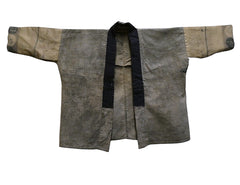A Han Juban or Half Under Kimono: Small Scale Edo Komon Pattern
early twentieth century
shoulder to hem x sleeve tip to sleeve tip: 22" x 42", 56 cm x 107 cm
This is a rustic han juban or a half under kimono that is fashioned from re-purposed cotton cloth.
The body of the han juban is crafted from pieces of Edo komon fabric.
Edo komon, is a small figured, all-over patterned cloth that was popular in the late Edo period (1603-1868).
During this time period the central government enforced laws on the population which regulated almost all aspects of life, dress included.
Most people in Edo era Japan were ordered by the government to dress in subtle, dark colors and small patterns; because of this, elaborate, very small patterned cloth was developed and then became popular, the reason being was that one could still wear figured clothing while not breaking any of the sumptuary laws that were laid down.
Countless tiny-figured designs were developed during this period and for this reason we know that the cloth which was used to create this garment dates to the 19th century. The pattern here is made entirely of small dots.
Look closely at the detail photos here and you will see how the han juban was pieced together and you will also see clever mending in the form of patches.
The sleeves seem to taken from a child's kimono of a type that date to the early twentieth century. The collar is of deep purple colored, very thin wool which has been marred by moths.
This is a charming garment whose component cloth spans decades, a typical feature of textiles hand stitched from re-purposed cloth.
A subtle beauty.


